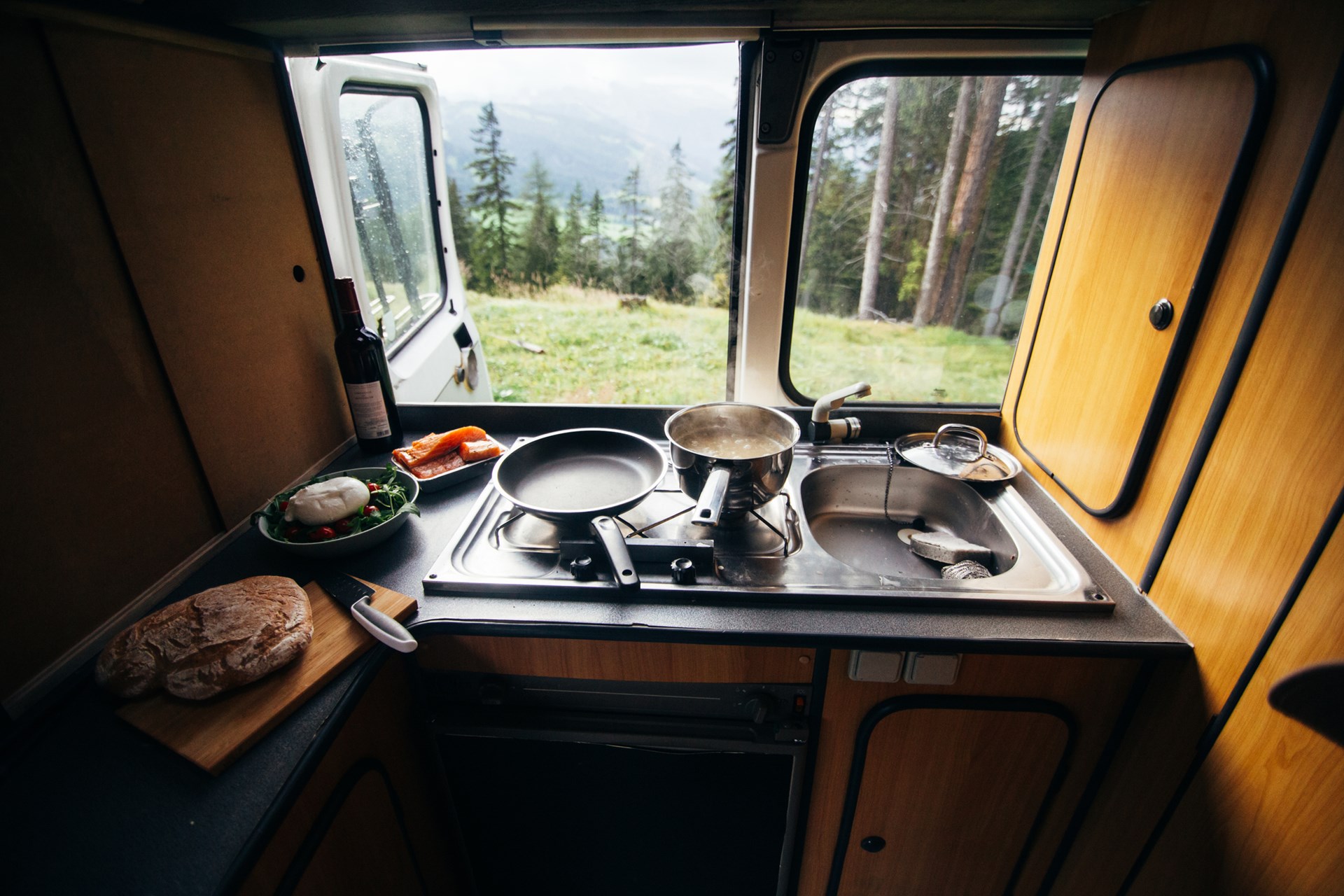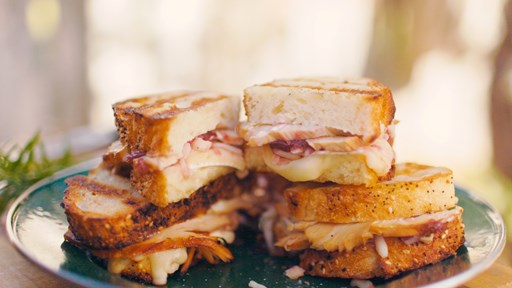You don’t need us to tell you that RVing is a great way to see the country, enjoy the outdoors, and escape your routine. By bringing along much of your daily needs, you can spend every night in a different location and undertake a new adventure every day.
One of the many benefits of RV travel is the ability to cook for yourself. You can save a lot of money by doing this, as cooking on your own can be much less expensive and healthier than paying to eat at restaurants or grabbing fast food.
In addition to that, if you have any travelers who are particular about food, by cooking your own meals you are assured of accommodating personal tastes and food allergies. Plus, you may find yourself with few dining options to choose from when RVing, especially if you’re traveling in remote areas.
If the thought of planning your camping trip and planning meals on top of that has you feeling stressed, we are here to change that. Though some people consider cooking a stressful part of RV camping we are here to show and tell you that it doesn’t have to be.
Here are ten of our top meal-planning tips to help make your RV cooking experiences easy, delicious, and cost-effective.

1. Plan Ahead
Cooking in an RV can be simple or as complex as you want to make it. As with most activities, being organized makes all the difference. Planning is especially important when traveling in isolated or remote areas.
Cooking everything inside the RV can get boring, but planning to cook everything outdoors on a grill, camp stove, or campfire puts you at risk of weather challenges. For variety, choose meals when planning menus that you can cook by different methods, such as a slow cooker, fry pan, or campfire.
Meal planning for RV travel includes gathering recipes that lend themselves well to RV and campout cooking. Choosing recipes that use many of the same ingredients is especially convenient.
To help spark some ideas of what meals to plan, be sure to check out the KOA database of recipes (more on that below).

2. Create the Menu in Advance
Plan out your entire trip menu for the best results, especially if you’ll be away for a week or less. This makes it possible to save space by stocking your RV with only the cooking tools and ingredients you know you’ll use.
Many RVers planning for a trip of two weeks or more will lay out a one-week menu and then repeat it as many times as needed with a few changes. For example, Week 1’s grilled chicken and potatoes may be altered for Week 2 to fried chicken and french-fried potatoes, or Week 1’s baked apples may take the form of apple pie or cobbler in Week 2.
For each meal, determine what you’ll need in terms of cooking vessels, utensils, spices, and ingredients. Summarize the results by combining or removing duplicates, and there’s your meal-planning packing list.
Some ingredients that must be kept cold or frozen may need to be purchased while on your trip. However, you should pack all ingredients that you can in advance. Depending on your menu, some may be difficult to obtain near your destination, and you may pay a lot more for whatever you can get.
If you are not planning the menu for your entire trip in advance, pack those additional items you are likely to need that can be difficult to find. For example, if you strongly prefer a particular brand of hot sauce or steel-cut oatmeal, you are probably better off stocking them before you go.
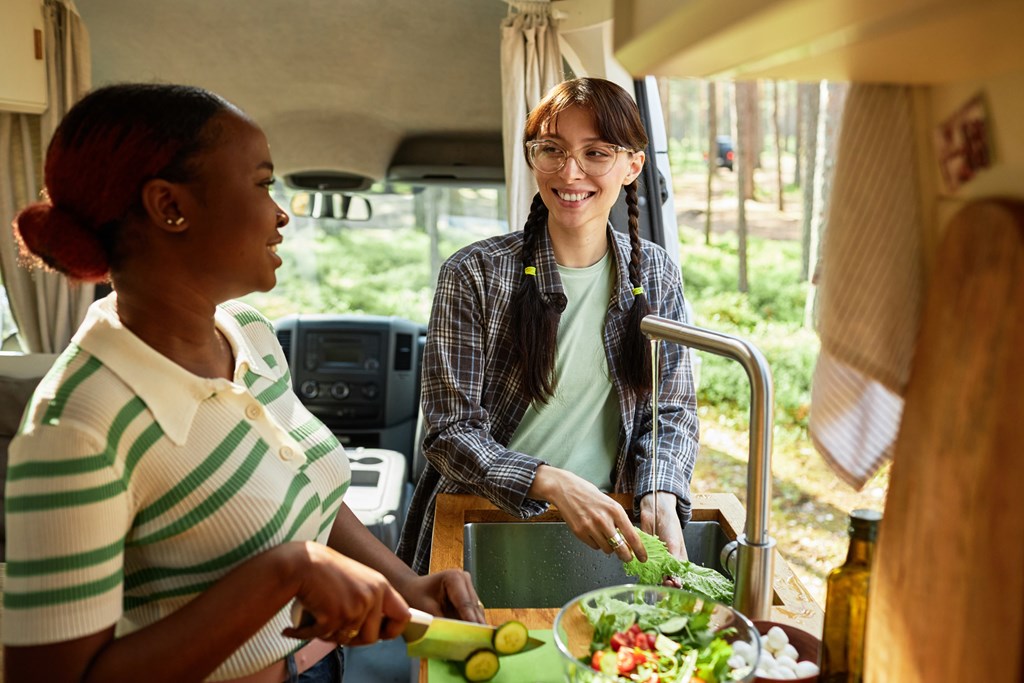
3. Recipes for RV and Campfire Cooking
Many family recipes can be adapted to cooking in an RV or over a campfire. However, if you don’t want to do that or are just looking for some new options, you’ll find hundreds of recipes on the KOA website:
Most of these were contributed by KOA members who have used them on their RV camping trips, so you can be assured that they are not just delicious but also easy to prepare.
4. Think About Temperatures
Most RV refrigerators can be operated off the battery while driving and then off the electrical hookup once you park. Some of today’s RVs are even equipped with solar panels or portable power stations for use when a hookup isn’t available.
However, you want to plan some meals that don’t require refrigerated foods. This makes you less dependent on refrigeration overall and lessens how often the fridge door needs to be opened while on the road.
If your RV refrigerator doesn’t run while driving, keep a re-freezable ice pack in your freezer and move it to the fridge whenever you leave the hookup. Or purchase a bag of ice and put it in the refrigerator while driving to help keep the contents cool.
Are you planning on boondocking? That’s a little trickier. If you plan to camp without RV hookups, you’ll probably want to invest in a high-quality cooler engineered to keep food and drinks cold for 4-7 days at a time. Well-known brands of these coolers include Yeti, Rtic Outdoors, and some Coleman models.
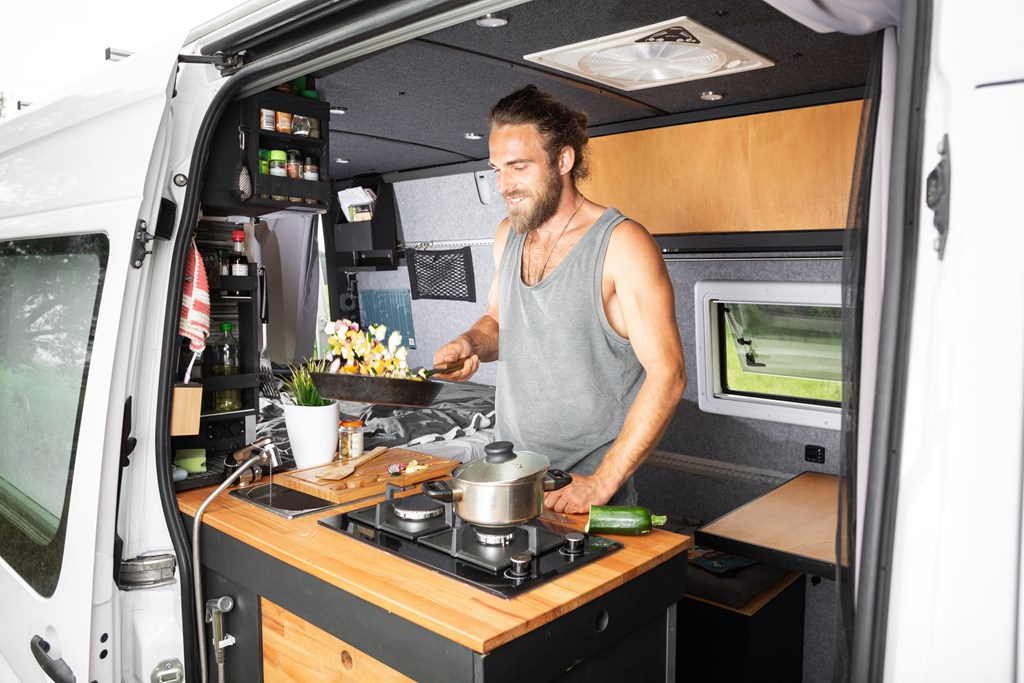
5. Pack The Equipment & Tools Needed
The cooking vessels, utensils, and dinnerware that have proven popular with RVers are listed below. Let these inspire your menu selections, but remember, only bring along what you need to prepare your chosen meals.
- Slow Cooker: Load it up in the morning, enjoy a full day sightseeing or being out on the beach or trail, and come back hungry to an RV filled with the heavenly smell of a good meal.
- Instant Pot: When you want to cook something quickly, this modern version of the traditional pressure cooker is all you need.
- Air Fryer: For those trying to cut down on the spatter and calories created by traditional frying, a small air fryer cooks quickly and takes up about the same amount of space as a drip coffeemaker.
- Cast Iron Skillet or Dutch Oven: Great for frying, boiling, and baking, a cast iron skillet or Dutch oven is a must-have for meals cooked over the campfire. They also cook well on RV kitchen stoves and ovens.
Pro tip: For a yummy breakfast treat, place refrigerated, ready-to-bake cinnamon rolls in a greased cast iron frying pan or Dutch oven, cover, and cook over the campfire or on the camp stove, grill, or RV kitchen stove until done. Add icing, and enjoy!
- Stovetop Pans: Bring one larger pot for main courses (probably not needed if also bringing a cast iron Dutch oven) and two sizes of saucepans for side dishes.
- Coffeemaker: If your RV does not already have a coffeemaker, consider bringing along a pour-over coffee carafe or aero-press. Neither requires electricity, although you do need access to boiling water. Of course, if you prefer, an electricity-powered drip coffee maker or espresso machine (yes, you can have coffee shop level beverages in your RV) is also great!
- Food Prep and Cooking Utensils: Cutting board, chef’s knife, paring knife, spatula, tongs, stirring/serving spoons.
- Dinnerware and Mugs: Many people like wheat straw dinnerware and cups because they’re eco-friendly, or melamine because it comes in many patterns and is hard to break. Some insist on Corelle or stoneware. For each person, bring at least two of everything (plate, saucer, bowl, mug, glass), or at least one per person per meal if using disposables. You may also want to bring a platter and serving bowl.
- Eating Utensils: While they are easy, avoid disposable utensil options and take a set of inexpensive serrated knives for cutting meat.
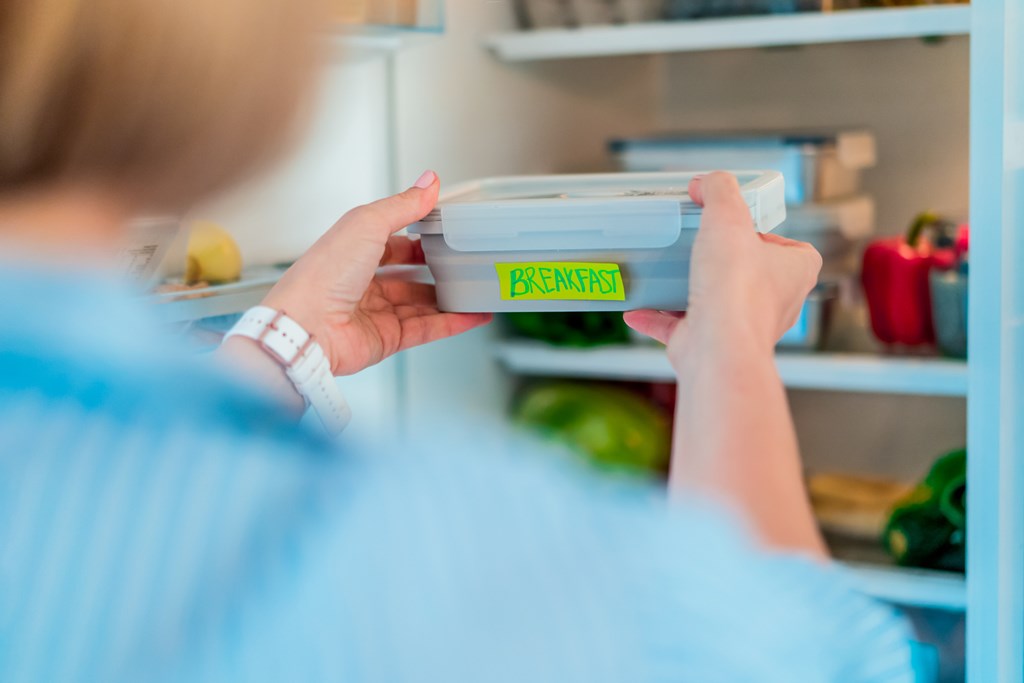
6. Batch Prep
You’re going RVing to escape your everyday routine and to sightsee and relax, right? So cut down on time needed for cooking by doing as much batch prep in advance as you can.
Do several of your planned recipes use ingredients such as chopped onions or minced garlic? Prepare these before you leave and bring them along in sealed containers. The same goes for cutting meat into strips or tenders.
Consider cooking one or two entire meals in advance to allow for heat-and-eat meals on days when you don’t feel like cooking. As a bonus, some recipes tend to taste better after a day or two in the fridge than when first cooked, especially those containing pasta, rice, or beans.
Certain foods freeze exceptionally well. If your RV has freezer space, consider making foods like pancakes, muffins, or pies in advance and freezing them in individual portions to thaw as needed.
Some convenience foods are also perfect for RVing because they are so versatile. Rotisserie chicken, for example, can be used alone as a meal entree or combined with other ingredients to make a different entrée or sandwich.
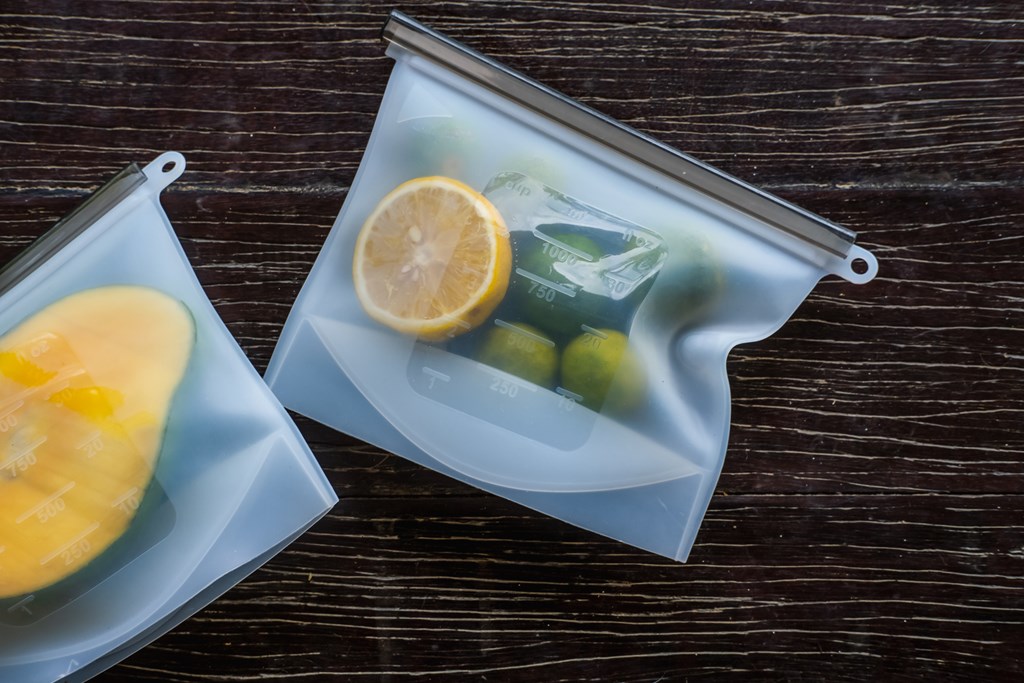
7. Food Storage Tips
One common factor in all RVs is a relative scarcity of storage space. Fortunately, food storage doesn’t have to take up a lot of room.
- Refer to your meal-planning list and pack only what’s required. Bringing along vessels, utensils, or ingredients that you aren’t going to use is a waste of valuable space.
- Ensure you use all available storage spaces, including the fridge and freezer, cabinets, shelves, and drawers. If you have more refrigerator space than needed but not enough room for non-refrigerated foods, temporarily store some of the latter in the fridge.
- Get creative with storage. For example, an over-the-door shoe organizer mounted on a cabinet or door can hold canned goods, bagged pasta, snacks, and similar foods.
- Keep a supply of zip-style or slider-style plastic bags. They come in handy for many uses beyond just food storage! For extra durability, choose freezer bags.
Above all, keep things organized so you can grab what you need without having to search all over the RV to find it.
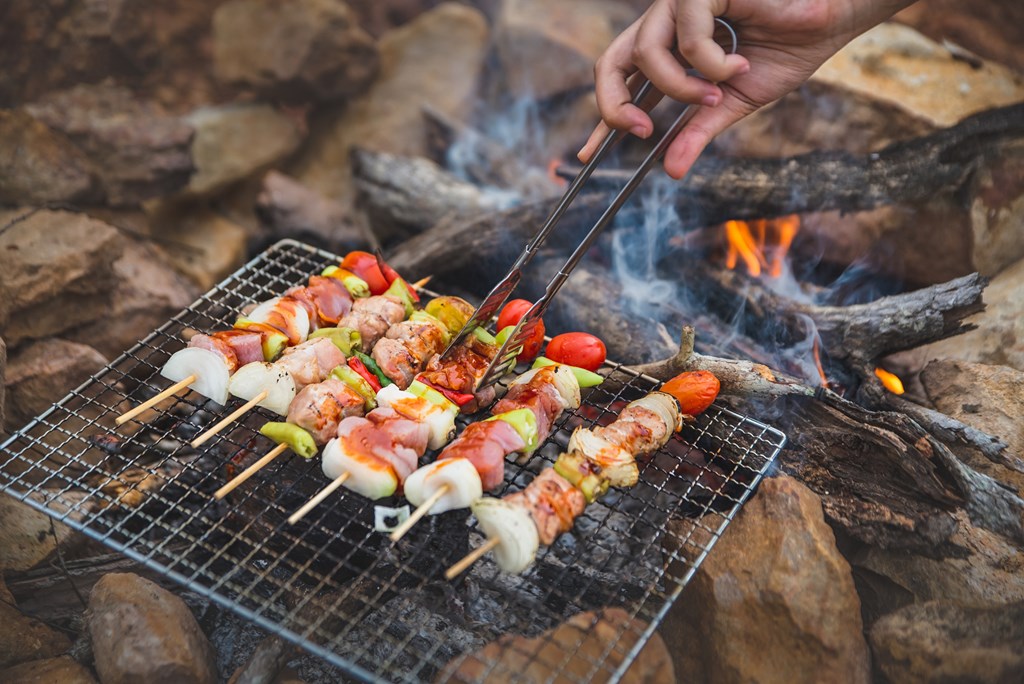
8. Keep Meals Simple
Kitchen cooking and prep space are at a premium, even for those with a large or luxurious RV. For successful, hassle-free cooking, choose simple meals that don’t require numerous ingredients or steps.
With the many recipes available specifically for RV and campout cooking, you’ll find plenty of easy-to-prepare meals for just about every taste.
And don’t forget the campfire! Unless you’re parking the RV in an area that prohibits fire pits or charcoal grills, take advantage of having access to a fire or hot coals to grill meats and vegetables and enjoy beloved cookout treats such as roasted marshmallows and s’mores.
9. Use Leftovers to Make New Meals
Even when designed to make enough for just one meal, some recipes will result in leftovers. Of course, you can use the leftovers as-is for another meal, but that can get boring fast.
Consider ways to use leftovers to vary your meals. For example, use baked or fried chicken to make chicken salad or a casserole. Combine leftover meatloaf with taco seasoning, and you have the seasoned ground meat needed to make tacos, nachos or taco salad.
In addition to delighting your taste buds, finding creative uses for leftovers reduces food waste – good for your wallet and the planet!
10. Get Familiar with Your RV Kitchen
Have you bought a new RV or rented one that’s new to you? Before the trip, take some time to review the kitchen area and appliances. See what you have to work with and ensure you know how to operate everything. Consider what adjustments you may need to make to your food preparation and cooking habits.
You don’t want to find out on that first glorious morning of your trip that you don’t know how to work the built-in coffee maker – or start dinner that evening only to discover that the stove’s highest setting isn’t hot enough to deep fry your newly-caught fresh fish.
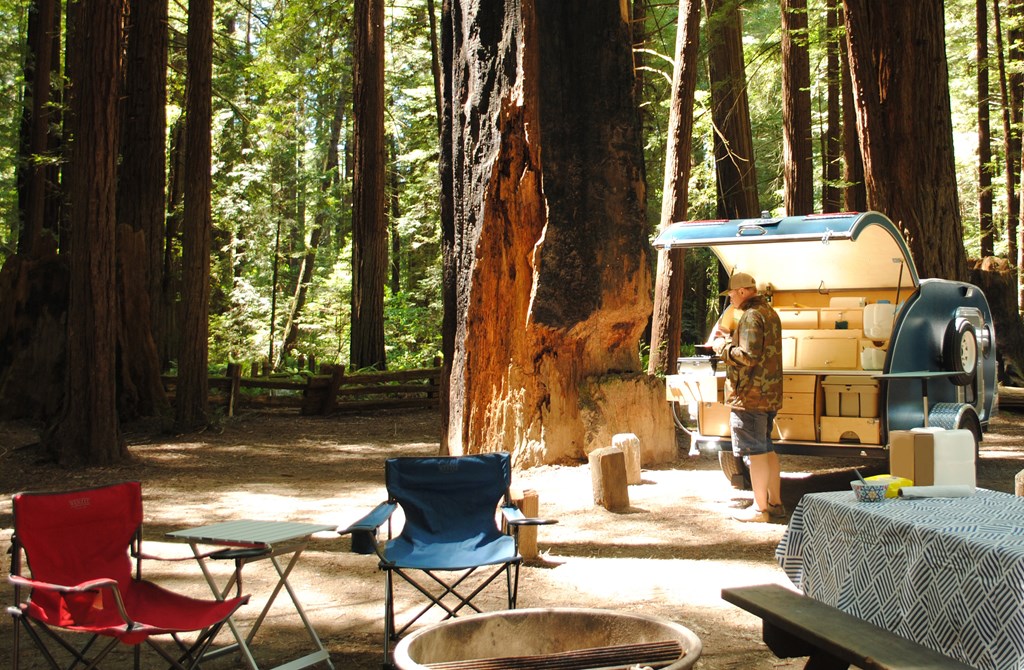
Plan and create menus in advance for the best experience with RV cooking. For trips longer than a week, consider making a one-week menu that repeats with some changes.
Batch-prepping ingredients, choosing simple recipes, and making creative use of convenience foods and leftovers will minimize the time, expense, and stress involved in cooking without sacrificing taste or variety.
Become familiar with your RV kitchen and be prepared to adapt your food preparation and cooking habits as needed. To ensure you have enough storage space, stock your RV with only the cooking vessels, utensils, spices, ingredients, and dinnerware required to carry out your menu plans.
RV meal planning and cooking ensure that you’ll have tasty meals that accommodate any allergies, are healthier than many restaurant options, and save money compared to eating out.
Don’t let the stress or fear of meal planning stop you from getting out there and adventuring. Using the ten tips outlined above, you’ll have a far better food experience and may discover that you enjoy this aspect of RVing as much as the travel itself.

Leslie is a freelance travel and health/wellness writer who gets butterflies from telling stories and sharing information with readers across the globe. Her voice comes from a place filled with passion and dreams.
With over 10 years of experience in crafting words and years of embarking on travels that have taken this Montana girl to some incredible places, Leslie loves the adventures of both body and mind her writing takes her on.
To see what Leslie’s up to in the writing and design world, visit her website here.



















